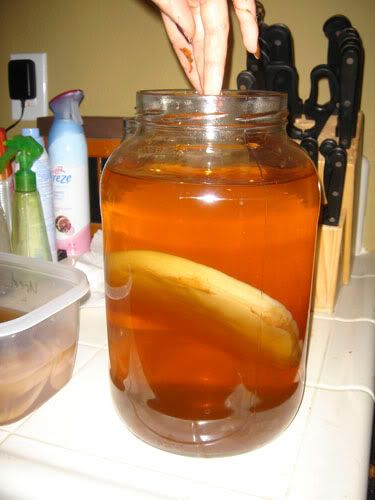I am a BIG fan of Kombucha tea and have been for roughly 4 years. I believed it helped my transition into raw foods significantly easier. Personally speaking, it sped up my metabolism pretty significantly as well helped control my appetite. Being the 'Do It Yourself-er' that I am, it is really no wonder why I started brewing it myself. I have been brewing on my own now for about 4 months and am having a blast doing it!
Kombucha is one of those products that I believe takes a good while to master. I am still in those stages! I am really just trying to find the perfect tea for my personal palate as well as the perfect brew strength. I have a couple different batches going on right now testing those exact areas. I am excited for the results.
This upcoming batch I plan on experimenting more with flavorings like Ginger, Mango and Strawberry. My favorites to juice (which you'll see me mention in almost all my favorite Juices) are Pineapples and Oranges but I will leave those out due to their naturally acidic properties. The three flavorings above are also popular flavorings of commercially purchased teas. I also enjoy making Kombucha smoothies in which I blend a half bottle of Kombucha in with some fresh fruit. This may be a great way for anyone new to Kombucha to drink their tea since the fresh fruits tend to take the bite out of the drink.
Top 10 Noticeable Benefits of Drinking Kombucha Tea Daily
+ Prevents Acid Reflux
+ Assists With Weight Loss
+ Aids in Digestion of Heavy Meals
+ Strengthens Hair, Restores Hair
+ More Energy in the Morning
+ Helps With Sleep
+ Relives Constipation
+ Post Work Out Recovery Drink (Cardiovascular and Resistance Training)
+ Reduces Severity of Hangovers
+ Better Skin Complexion, Tighter Skin Tone
I have listed the instructions that I recommend below as well as all materials needed immediately following my personal pictures from my last batch brewed on September 2nd.



*I would like to mention the importance of cleanliness. Please wipe all surfaces down thoroughly prior to brewing and wash hands with an antibacterial soap or wear powder free surgical gloves!You will be dealing with a LIVE culture and it is vulnerable to outside bacteria... and not the good kind we want!*
The Basics
1 kombucha culture (or scoby)
2 litres of water
3 or 4 tea bags or 3 or 4 teaspoons of tea (green, white, or black tea)
1/2 cup to 1 cup Agave nectar
200 ml of kombucha from a previous batch as a starter or 2 tablespoons of cider vinegar if you don't have any kombucha.
The Equipment
A large glass jar (roughly a gallon)
A bandanna or a thin enough cloth to allow the brew to breath.
A rubber band or piece of elastic to secure the cloth
A teapot or saucepan to brew the tea in
A strainer (if you go with loose leaf tea, which I would recommend)
Some bottles for storing the finished drink
The Method
Make a pot of tea with the tea bags and leave it to brew for 5 to 10 minutes. I find that over brewing the tea, especially black, leave a bitter taste to the final product. Alternatively, add your tea to a saucepan and simmer it gently for 5 minutes (I use a loose leaf tea so a saucepan is my method)
Strain the tea into your large glass jar, add the nectar and stir it until it dissolves. Now add cold filtered water to bring the tea up to 2 litres. Hot tea can kill the culture! It should be no more than blood heat before you add your culture, so if it’s still too warm then let it cool down before you add it to the jar.
Making the brew
Into the large glass jar, put the starter liquid from the previous batch of kombucha. If this is your first batch then use 2 tablespoons of cider vinegar as your starter, (It adds the acid environment the culture likes) or some commercial kombucha if you have some. Once you’ve made your first batch you’ll have your own kombucha to use as a starter on the next batch.
At this point you should have your brewed tea, nectar and starter liquid in the large glass jar!
Add the kombucha scoby.
Pick up your scoby and slide it into the bowl. I find that the younger the scoby, the more likely it is to sink and the older they are, the more they will float at the top. I have no idea if this is true for everyone but for me it has been common. If the scoby has a 'dirty' side where it's darker in colour and has beard like brown bits sticking to it then put that side facing down into the tea. The brown bits are yeasts.
Cover it and leave it to ferment
Put your cloth over the bowl and secure it with a rubber band or a piece of elastic. This keeps contamination out of your culture so it’s important to cover it properly!
Put the bowl in a warm dark place (23°-30°C or 70°-86°F) like a corner on the kitchen counter. I must stress that it is crucial to not disrupt the process so place it in an area where it can go undisturbed for its full process! I have had to move brews in the middle of their run (I was moving) and BOTH scoby's were ruined!
I hope this helps anyone with their Kombucha journey! There are also some good videos on YouTube although you may have to sort through a bit!
Cheers and good health!
The Coffee Self-Talk 2-Minute Gratitude Journal
2 years ago





0 comments:
Post a Comment